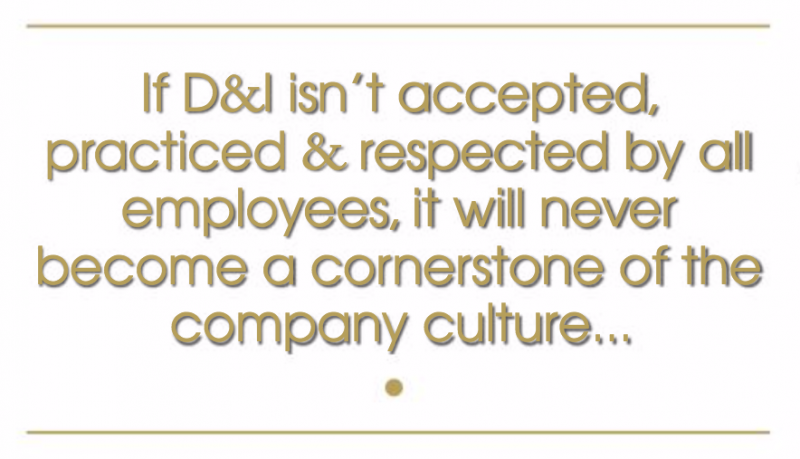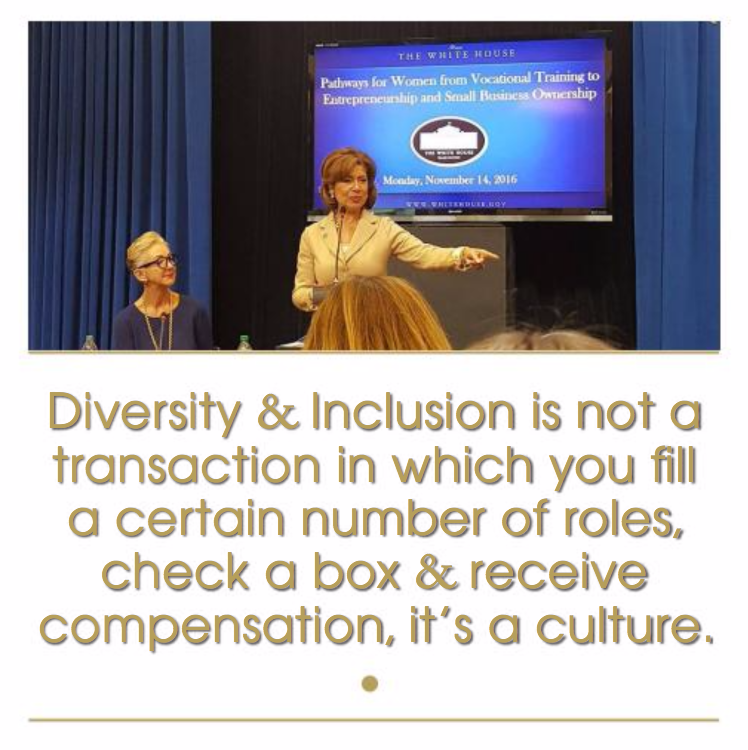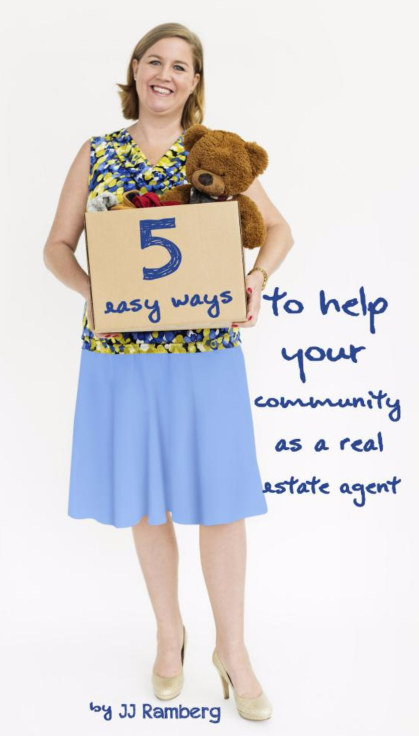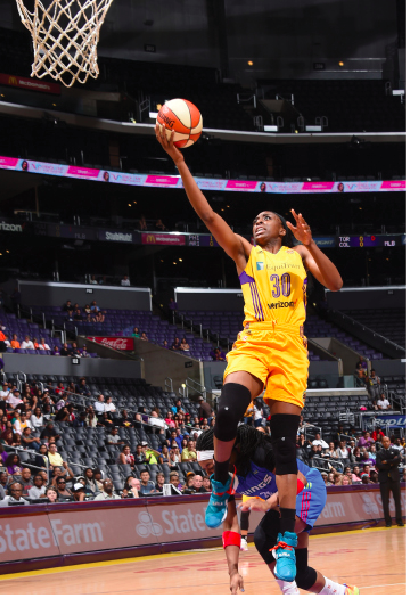
1. FHFA Proposed Amendment: Ensure that the regulated entities fulfill the letter and spirit of their legal obligation to promote diversity and ensure the inclusion and utilization of minorities, women, and individuals with disabilities as well as minority-, women-, and disabled-owned businesses, in all their business and activities:
NAWRB Response: It is imperative that regulated entities make a strong and impassioned effort to ensure they are fulfilling the objectives of diversity and inclusion (D&I). This means that entities, and their employees, need to be well-versed in the letter of the FHFA Office of Minority and Women Inclusion (OMWI), which can be assisted by effective communication, observation and execution.
The inclusion of the phrase “letter and spirit” is vital because D&I should be something each company supports and adopts in their culture and ethos, throughout all levels. From board members to entry-level employees, the value of diversity should be seen and felt. There needs to be an emotional feeling or connection to drive the culture of D&I, similar to a childhood experience or fond memory. By developing a related emotion that is constantly evolving as the tide changes, a company’s culture becomes the leading edge and doesn’t become an outdated structure. The baseline and tangible action of entities utilizing minority-, women- and disabled-owned businesses must be driven with a genuine motivation to provide better and more business and career opportunities for all.
2. FHFA Proposed Amendment: Clarify that the requirement to promote diversity and inclusion applies to all the regulated entities’ operational, commercial and economic endeavors, including management, employment, contracting, capital market transactions, and affordable housing and community investment programs;
NAWRB Response: This clarification is critical in ensuring that the objectives and goals of D&I reach beyond a single area of an entity’s practices, such as only implementing diversity in hiring practices or suppliers. Minority-, women- and disabled-owned businesses are available throughout all operational, commercial and economic endeavors which an entity can utilize.
Regulated entities’ D&I efforts should be fully integrated in their operations, rather than be isolated efforts. Overall, D&I can reach its greatest potential if entities adopt it in all aspects of their business practices. It is our goal that entities make intense efforts to utilize diversity and inclusion practices within their business, making it second nature as a daily routine. The cascading effort of D&I within a community provides more equality for job opportunities, business ownership, homeownership and wealth growth for future generations.
3. FHFA Proposed Amendment: Require the regulated entities to develop a stand-alone diversity and inclusion strategic plan or incorporate diversity and inclusion into its existing strategic planning process and adopt strategies for promoting diversity and ensuring the inclusion of minorities, women, and individuals with disabilities as well as minority-, women-, and disabled-owned businesses;
NAWRB Respons e: The regulated entities must be required to incorporate D&I into an existing plan as this would establish a new corporate baseline. As long as D&I is a separate strategic plan, it will be perceived as an afterthought, increasing the possibility of it not being as valued or executed within the entity’s overriding structure. The FHFA OMWI was formed in 2011, but it wasn’t until last year that the first strategic plan was crafted, and D&I wasn’t a hot topic or taken seriously in several aspects in the community at large. NAWRB is proud to see FHFA OMWI’s commitment to improve D&I within our industry. A clear, integrated plan helps entities grow an emotional and executable D&I culture and have a course of action through which to advance it.
e: The regulated entities must be required to incorporate D&I into an existing plan as this would establish a new corporate baseline. As long as D&I is a separate strategic plan, it will be perceived as an afterthought, increasing the possibility of it not being as valued or executed within the entity’s overriding structure. The FHFA OMWI was formed in 2011, but it wasn’t until last year that the first strategic plan was crafted, and D&I wasn’t a hot topic or taken seriously in several aspects in the community at large. NAWRB is proud to see FHFA OMWI’s commitment to improve D&I within our industry. A clear, integrated plan helps entities grow an emotional and executable D&I culture and have a course of action through which to advance it.
Accountability is a crucial aspect of D&I and too often it falls by the wayside. Establishing goals and strategies would reveal whether or not an entity is succeeding in their strategic plan.
A collateral benefit of these plans is the resulting D&I information. By being able to clearly identify both what goals are being met and which approaches are working, the FHFA can better advise and guide the regulated entities.
4. FHFA ProposedAmendment: Require the regulated entities to amend their policies on equal opportunity in employment and contracting to include sexual orientation, gender identity, and status as a parent to the list of protected classifications;
NAWRB Response: By requiring entities to amend these policies, the FHFA is giving confidence, a presence, and a voice to workers who may have previously lacked one. This bolsters diversity, extending it further than being a minority, woman, or disabled.
The difficulties some individuals have endured, from school bullies to lack of family support, are arduous. Continually transitioning from one stage of life to another without receiving acceptance or consideration is exceptionally discouraging. With this amendment the FHFA can help put a stop to this cycle. You may have experienced a difficult time in school and been discriminated against in your personal life because of who you are, but this stops in the workplace. In the professional environment you need to be treated equally.
Employees should feel comfortable in their professional environment and be given the opportunity to grow and develop. By the same token, companies should expect quality work from their workers. If a person doesn’t feel comfortable being who they are at work, is a company truly leveraging their entire potential?
Everything from gender identity to being a single parent affects workers, and in turn impacts their work and professional environment. These new classifications reveal more about a person and company culture, thereby helping us understand each other better and be able to advance true diversity in more regards.
Diversity is about including everyone, and the FHFA is helping increase inclusion for more groups and protected classifications.
5. FHFA Proposed Amendment: Encourage the regulated entities to expand contracting opportunities for minorities, women, and individuals with disabilities by working with prime contractors (tier 1) to provide subcontracting (tier 2) opportunities to minority-, women-, and disabled-owned businesses;
NAWRB Response: Encouraging expanding contracting opportunities for minority-, women- and disabled-owned businesses deepens the culture of D&I. The word “encourage” should be replaced with “requires” to develop a better D&I community which strengthens the entire workplace, from entities to contractors and even subcontractors. This greatly contributes to creating an ecosystem that embraces D&I and prevents entities from becoming complacent after establishing and pursuing in-house strategic plans.
Goal 1: Design a Comprehensive OMWI Operational Structure in the FHFA’s OMWI Strategic Plan for FY 2016-FY 2018 states, “OMWI will ensure that agency employees, as well as external stakeholders, understand their respective roles and responsibilities in fulfilling the OMWI mission. This will enable OMWI to target required or desired skills development programs or initiatives and growth opportunities for OMWI staff.”
The FHFA’s effort to expand D&I responsibilities and efforts further than internal employees and stakeholders is vital. Diversity and inclusion cannot be a tenet you promote only within your entity; this would be like recycling soda cans in your own house but not trying to do so in public. This limits the positive effects of your internal practices and partly counteracts them with your actions outside of your entity.
 Diversity and inclusion is the right thing to do. An inclusive workplace is a better workplace, both in performance—as a recent Grant Thornton study reveals the opportunity cost for American S&P 500 companies lacking gender diversity in their boardrooms is $567 billion—and in company culture.
Diversity and inclusion is the right thing to do. An inclusive workplace is a better workplace, both in performance—as a recent Grant Thornton study reveals the opportunity cost for American S&P 500 companies lacking gender diversity in their boardrooms is $567 billion—and in company culture.
As mentioned above, accountability is a problem and professionals are often left wondering who will enforce D&I. The answer is everyone, from whole agencies down to each individual, and this amendment would contribute to their accountability. Creating a culture that isn’t simply built on satisfying the requirements but reviewing the spirit of the amendments to implement D&I at every level of business practices is the goal.
The job isn’t done after you hire women in your entity, it isn’t finished when you make sure you hire a minority contractor, the responsibility extends as far as keeping your suppliers accountable for their D&I practices and company culture. You don’t just pass the buck and forget about it.
Entities must make sure they’ve established an efficient, sustainable system that will keep D&I at the forefront of their business practices. Diversity and inclusion isn’t an initiative or trend, it’s a company value, one whose absence naturally behooves us to question a company’s spirit and ideals.
Providing an incentive program for all management levels with goals broken down into two components of evaluation—results and effort—could prove effective in driving D&I in the workplace. This program’s contribution would be two-fold; first, it would establish a financial development culture encouraging professionals to hire minorities and women, secondly, it would reward not only on results, such as meeting a quota, but on a person’s effort and proactive approach to developing D&I.
 Diversity and inclusion is not a transaction in which you fill a certain number of roles, check a box and receive compensation, it’s a culture. By not creating a system strictly reliant on metrics, entities can help employees better understand and connect to their D&I work.
Diversity and inclusion is not a transaction in which you fill a certain number of roles, check a box and receive compensation, it’s a culture. By not creating a system strictly reliant on metrics, entities can help employees better understand and connect to their D&I work.
By helping your employees understand the reason and importance of the company value, employees’ passion and meaning in their work will grow.
It is imperative that the incentive program extend to all management levels, thereby including all tiers of a company and not simply employing a “trickle down” mentality by focusing on top executives. If D&I is perceived as primarily a top executive responsibility, the way it is regarded at lower levels in the company will decline incrementally. Establishing D&I as a tenet and responsibility at all company levels makes it a value that is respected and pursued equally throughout the entire entity.
6. FHFA Proposed Amendment: Affirm that the regulated entities are authorized to expand the scope of their outreach and inclusion programs beyond the requirements of the Rule, which focuses on minorities, women, and individuals with disabilities; and
NAWRB Response: This amendment is a great way to encourage entities to give opportunities to more minorities than the ones outlined in the Rule. As the FHFA Minority and Women Inclusion Amendment notes, Section 1116 of the Housing and Economic Recovery Act of 2008 (HERA) focuses its attention on improving diversity and inclusion for women, minorities and individuals with disabilities, and, although inclusionary efforts for these groups should remain a priority, entities should aspire to expand their D&I efforts to include all minority groups.
Lesbian, Gay, Bisexual and Transgender (LGBT)-owned and veteran-owned businesses, for example, should also be given strong consideration for inclusion in an entity’s business endeavors. In addition, this amendment gives regulated entities the jurisdiction and protection to expand their D&I efforts to more minorities underrepresented in the field, especially when challenged by accusations of affirmative action. An entity can only benefit from being equipped with a variety of perspectives, knowledge and experiences that a diverse staff can provide.
There may be professionals who ponder if the D&I work is worth the results. The resounding answer is yes.
What’s the potential of D&I? Consider this: we have seen the incredible benefit of a small amount of inclusivity in our industry—such as higher revenues and happier work environments—imagine the progress and impact we could create by increasing D&I and achieving true equality for women and minorities. We don’t know what a truly inclusive workforce looks like because we have never had one.
The employees of the FHFA and the entities it regulates hold tremendous value in addition to their professional roles, from crafting award-winning films to passionately pursuing hobbies. Knowing a colleague shares a similar interest or that your superior is experienced in another field creates value and interest among workers, it provides another way in which to connect both in and out of the office. A person’s extracurricular activity may even provide a service to their company, like designing an advertisement or teaching a self-defense class.
There is so much more to people than their work life. By allowing employees to embody this, companies are equipping themselves with a workforce of well-rounded, rewarded individuals.
7. FHFA Proposed Amendment: Improve the usefulness and comparability of the annual reports to FHFA by requiring that the regulated entities provide information about their efforts to advance diversity and inclusion through capital market transactions, affordable housing and community investment programs, initiatives to improve access to mortgage credit, and strategies for promoting the diversity of supervisors and managers.
NAWRB Response: This is an incredibly useful and powerful amendment because it will plainly show whether regulated entities are being instrumental and successful in their D&I efforts. The amount of specificity being requested by the FHFA in these annual reports will help assess D&I success in all areas of an entity’s activity, and help ascertain which particular parts of an entity are thriving and/or declining. This data can be used to determine where D&I is being overlooked and the measures that can be taken to ensure it increases.
The importance of usefulness, and especially comparability, of annual reports cannot be overstated. A clear organized system for compiling annual reports helps the FHFA evaluate each entity efficiently and usefully. Entities are different and unique, but providing data that is easily comparable will prove incredibly valuable in helping truly implement D&I.
We also encourage semi-annual reports as a minimum and smaller tracking progress reports on a quarterly basis. These requirements would help the development of a dynamically changing culture by increasing organizational assessment.
 Further Suggestions
Further Suggestions
Public Reports
The FHFA and regulated entities should make their annual reports available to the public in mainstream publications and media outlets, as they directly impact American citizens.
Grading System
When assessing entities on D&I, the FHFA could utilize a grading system on diversity, much like restaurants are judged on cleanliness. This will hold agencies accountable in their D&I processes. Furthermore, a plus or minus sign next to the letter assigned to each agency could indicate an improvement or regression from the previous quarter.
Evaluate Effort
An entity desires to hire the best person for the job. For this reason we suggest evaluating entities on their efforts in hiring women and minorities not necessarily on their numbers. Simply because entities do not hire diversely does not mean they did not put in a concerted effort. Evaluate the quality of the effort to meet the number, not necessarily the number of outreaches or new hires; the value of the outreach is a better representation of D&I at an entity. Quality of effort must be weighted for D&I and not just based on pure numbers.
Mentorship and/or Training Programs
We believe that training and mentorship programs can be introduced without being a heavy burden on neither the entity nor its employees. Below you can find a list of ideas for potential programs:
Mentorships for women:
Women often start their careers in lower positions and may not be equipped for a higher role in comparison with other applicants. We suggest that entities create mentorship programs to prepare women for their next opportunity.
This will help ensure that women in lower positions have competitive qualifications when they get to the top. Additionally, these programs will help entities recognize women’s skills and abilities, possibly providing a return on investment if the company hires her or promotes her to an executive role.
Conduct training after work:
Have a program that takes place after work hours, so that the entity is not burdened by cost and employees have the opportunity to showcase their initiative on their own time. This can be composed of a structured one or two week training program, or can be spread out in incremental steps over the course of a few months.
Accessibility will be crucial for these mentorship programs. All employees have different lives and commitments, and the mindset needed to understand and consider the dissimilarities in employees’ lives is critical to understanding the D&I movement and its importance. If you can accept and respect the fact that a person may have responsibilities outside of work preventing them from being part of a regimented professional training program, then you can more easily comprehend the value of having a diverse and inclusive workplace and the importance of recognizing employees’ individuality.
From caring for their children and participating in intramural sport leagues to extensive commutes and health-based demands, you never know what a person is truly going through. Increasing accessibility enables more workers to take advantage of these valuable resources, allowing them to leverage professional opportunities without having to sacrifice personal responsibilities or commitments.
By recording the training sessions and posting them for employees to access, an entity is empowering its workers to be a part of the program on their own time and at their own pace. Additionally, the entity sends a clear message that it is equally inviting all employees to participate.
Regarding the burden these programs will have on the FHFA and its regulated entities, the Small Business Administration (SBA) offers several resources for training and advising professionals. These include Women’s Business Centers (WBC), Small Business Development Centers (SBDC) and the SCORE mentorship program, to name a few.
To the FHFA and the entities it regulates these resources represent a depository of potential speakers and trainers for their mentorship programs at no additional cost. What entity would pass on the opportunity to offer cost-free programs that can improve their employees and the industry as a whole? It’s a win-win opportunity with a powerfully beneficial outcome: implementing and promoting diversity and inclusion.
The perception of an entity that provides these services and takes care of their employees in this manner will be positive and spread throughout the industry. Not only will the entity connote an inclusive workplace and innovation, you will be regarded as a leader in diversity and inclusion.
These programs create a culture of advancement that has no color, gender or classification; they help level the playing field and help employees to feel empowered in their professional environments.
Collaboration:
Goal 3: Deliver Meaningful OMWI Communication in the FHFA’s OMWI Strategic Plan for FY 2016-FY 2018 articulates, “Communication is the foundation of organizational outreach. It increases commitment by building relationships; builds motivation by promoting an open and supportive environment; and drives behavior by expanding knowledge. Effective communication is critical if OMWI is to drive interest in, support for, and commitment to its mission and to ensure that internal and external stakeholders are both engaged in, and benefiting from, its work.”
 It is invaluable to have speakers come in who are passionate about contributing to the expansion of diversity and inclusion in the housing ecosystem, which can be made possible by establishing clear, effective communication between the entity and those who assist in the development of D&I. Both entity and speaker can benefit from being a part of this training program: entities will gain employees with the learned skills to contribute to the company’s overall success, and speakers will gain more exposure and contacts for their business affiliation.
It is invaluable to have speakers come in who are passionate about contributing to the expansion of diversity and inclusion in the housing ecosystem, which can be made possible by establishing clear, effective communication between the entity and those who assist in the development of D&I. Both entity and speaker can benefit from being a part of this training program: entities will gain employees with the learned skills to contribute to the company’s overall success, and speakers will gain more exposure and contacts for their business affiliation.
This effective collaboration must also be present within the agency. Internal employees must understand the commitment to D&I and embody it themselves. If D&I isn’t accepted, practiced and respected by all employees, it will never become a cornerstone of the company culture; diversity and inclusion will be viewed as a task and disregarded once it is addressed in even the most miniscule manner. In order to prevent this, the FHFA and the entities it regulates need to ensure that D&I is viewed and regarded as any other company tenet and ideal.
The time and energy contributed to the success of a mentorship and/or training program is miniscule compared to the overwhelming financial and emotional rewards that result. When employees feel as if their company cares about their future professional success and satisfaction, the increased morale in the environment lends itself to increased productivity. More importantly, it’s imperative that an entity is taking the initiative to make sure that women, minorities and disabled people are given the opportunity to realize their full potential.
In advancing diversity and inclusion, the FHFA is creating a domino effect that will impact several aspects of American life. From their internal employees to the entities they regulate and the people and businesses these entities work with and help, the FHFA is helping better the careers and lives of women and minorities across the country. With increased resources these groups can live more comfortable lives and even achieve the dream of homeownership.
Owning a home has the ability of creating stability for families and safeguarding a person’s professional accomplishments. On this foundation families can thrive and situate future generations for success. It’s a beautiful, attainable vision and it starts with diversity and inclusion.
Sincerely,
Desirée Patno
NAWRB CEO and President

 Login
Login


















 Many people have asked me how I was able to both build my business and reputation as a housing guru though the untraditional channel of social media. It wasn’t magic, but it did take time and a lot of work. If one is willing to put in the effort, any dedicated, reasonably intelligent person who is truly interested in their industry can do the same thing. The purpose of this article is to share my experience in building a social media presence and to provide a quasi-tutorial on how a real estate professional (be it an agent, broker, loan officer or anything in between), can learn to use the vast amount of data available on the internet to become a sought-after expert in their field.
Many people have asked me how I was able to both build my business and reputation as a housing guru though the untraditional channel of social media. It wasn’t magic, but it did take time and a lot of work. If one is willing to put in the effort, any dedicated, reasonably intelligent person who is truly interested in their industry can do the same thing. The purpose of this article is to share my experience in building a social media presence and to provide a quasi-tutorial on how a real estate professional (be it an agent, broker, loan officer or anything in between), can learn to use the vast amount of data available on the internet to become a sought-after expert in their field.

 I remember as a kid when I ordered my first Ben & Jerry’s ice cream and when I bought my first body lotion from The Body Shop. Those were the moments when it became very clear to me that business and doing good could go hand in hand. From then on I was always incredibly interested in the idea of socially responsible businesses.
I remember as a kid when I ordered my first Ben & Jerry’s ice cream and when I bought my first body lotion from The Body Shop. Those were the moments when it became very clear to me that business and doing good could go hand in hand. From then on I was always incredibly interested in the idea of socially responsible businesses.


 each ticket purchaser, each sponsor, has to be invested in this because this is a long term investment in the future of where we all live, work and play,” Simmons explains. “And in order for that to happen, the ecosystem has to be able to sustain itself.”
each ticket purchaser, each sponsor, has to be invested in this because this is a long term investment in the future of where we all live, work and play,” Simmons explains. “And in order for that to happen, the ecosystem has to be able to sustain itself.”